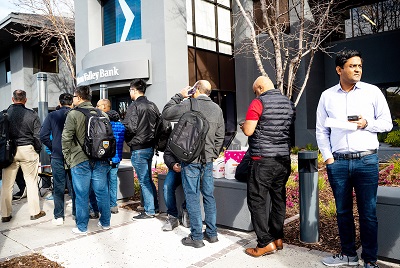The Australian Alert Service is the weekly publication of the Australian Citizens Party.
It will keep you updated on strategic events both in Australia, and worldwide, as well as the organising activities of the Citizens Party.
To subscribe to the Australian Alert Service, it's easy, and it's secure.
Lead Editorial
15 March 2023
Vol. 25 No. 11
Imagine a towering crystal palace constructed upon the broken, unstable foundations of a previous, crumbled edifice. This is what we have created atop our broken global economic and strategic system. Actions to save the financial system since 2008 have left banking structures more vulnerable than ever; actions to secure us against security “threats” since 2001, including wars launched supposedly to keep us safe, have made us less secure.
This structure we have made will shatter, sooner or later.
Will it be set off by the latest financial tremors? Three American banks have collapsed within several days, including the second biggest bank default in US history after the collapse of Washington Mutual in September 2008, that of Silicon Valley Bank (SVB) on 10 March. Crypto bank Silvergate collapsed on 8 March due to losses on bonds that it was forced to sell after a run on deposits from its crypto company clients. New York-based Signature Bank was closed 12 March by state regulators. A fourth bank, First Republic Bank in California, has experienced its own bank run, teetering on the edge (pp. 10-11).
After intensive discussions between the White House, US Federal Reserve, Treasury and Federal Deposit Insurance Corporation (FDIC), on 12 March the White House announced that depositors would be protected, with President Biden assuring Americans that “the banking system is safe”. Depositors will be made whole by FDIC funds filled by fees paid by banks. This might hold for the moment, but as public bank activist Ellen Brown has written, that fund “is sufficient to cover only about 2 per cent of the US$9.6 trillion in US insured deposits”.
SVB was America’s 16th-largest lender. Owing to the growing crypto bubble, its deposits had tripled in 2019- 21. But 50 per cent of its balance sheet was tied up in long-term securities. It faced a major squeeze as interest rates continued to rise, having to pay out higher shortterm rates on deposits than the interest earned on its longer dated bonds, which were declining in value. Selling the bonds to maintain liquidity as depositors pulled out, made paper losses real, leaving a massive hole in the bank’s balance sheet.
All the same mistakes were made with these troubled institutions as during the GFC (ratings agencies failing to reassess; lack of federal intervention and regulation). The plan to prevent contagion is more of the same: On 12 March, the US Fed announced a new lending backstop for banks, the Bank Term Funding Program. The one-year loans are secured by Treasury bonds or mortgage-backed securities. In the UK, a fast intervention pre-empted immediate spread, with HSBC buying up SVB UK for £1 after discussions with the government and Bank of England.
SVB had nearly US$30 billion in derivatives, a small sum compared to the tens of trillions held by large US banks, but which can set a fuse for a larger crisis. Banking expert Martin North told the Daily Mail on 15 March that it was too soon to tell whether a bigger crisis could be triggered, but Australia is not immune. “We are joined at the hip with the US because a lot of our funding comes from international markets, particularly the US and of course, our exchange rate is also very strongly linked to what happens in the US.”
All of this adds to the declining credibility of the US dollar order, while China, Russia and India propose a new economic and security architecture backed by the majority of the world (p. 12). As this is happening, military tensions between the USA and Russia have just escalated with Russian fighter jets downing a US surveillance drone over the Black Sea overnight. Australia is being dragged further to centre stage in the next US proxy war, against China, with the new AUKUS submarine deal (p. 6). Yet with its diplomacy fostering Saudi-Iranian relations, China is showing how peace can be achieved. (p. 12)
In this issue:
- Without warning NAB cuts off small business from online banking
- Australia Post banking expansion in ‘national interest’
- Canavan to Westpac: What does ‘consultation’ mean?
- AUKUS is a $400 billion suicide pact
- New Zealand—NATO’s guardian of the South Pacific
- Silicon Valley Bank collapse: the crash is on!
- Fed tries to fix collapsing banks with same old recipe
- China diplomacy a global game changer
- G20 gives voice to ‘Global Majority’
- Have you made your submissions?
- Our economic model is based on permanent austerity
- ALMANAC: World reacts to China’s peace initiatives
- World War III, or peace? Support China’s peace plan!
- Beijing takes the initiative in Ukraine conflict
Click here to find out how to subscribe. For freely available AAS articles, click here.
Click here for the archive of previous issues of the Australian Alert Service








